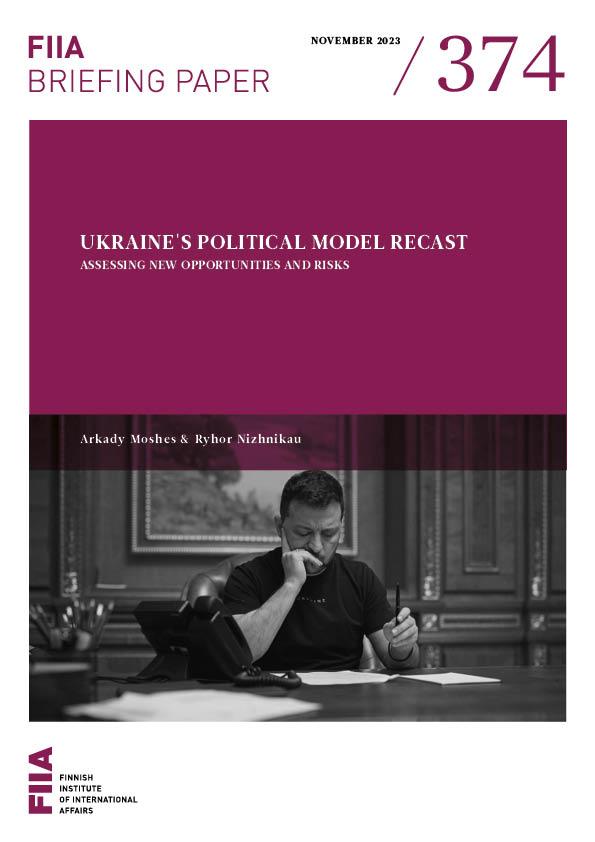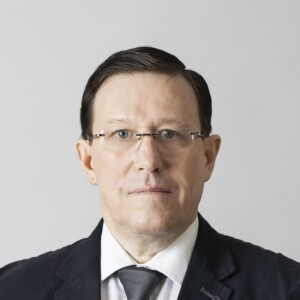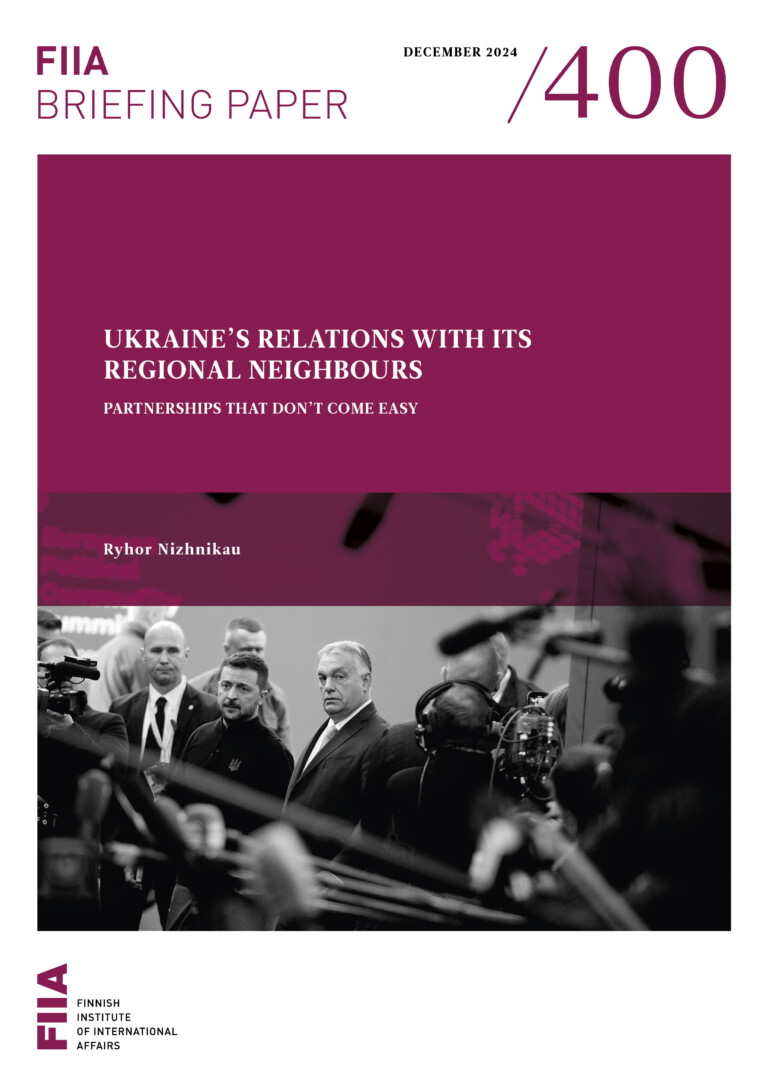The Ukrainian political model is in flux. The war against Russia has eroded the core elements of the old order, in which elections were a focal point of the political contestation and the main mechanism for resolving political conflicts.
Oligarchs have lost their critical role in Ukrainian politics. Their impact on the media and the party system has weakened considerably, which is a very positive development for the country’s democratic progress.
At the same time, the disappearance of the oligarchs as a quasi-institution facilitates the process of power concentration around President Volodymyr Zelenskyy and his Office. Given the absence of elections due to martial law, this poses the risk that the new political model might be tailored to the incumbent’s needs to the detriment of the public interest.
As the war becomes protracted, societal pressure to reactivate comprehensive reforms in the country, including the fight against corruption, is increasing. This creates certain tensions between the national leaders and the general public. Ostensibly, the incumbent president cannot and will not be able to ignore this demand, especially if it is firmly and consistently supported by Western actors.
Introduction
Russia’s invasion has had a drastic impact on both the Ukrainian elites and Ukrainian society. For three decades since becoming independent, the Ukrainian political model had combined an informal clan-based power distribution with formal political pluralism and free – albeit not necessarily totally fair – elections. The oligarchic structural dominance in national politics survived both authoritarian turns and revolutionary uprisings, even if societal pressure to get rid of the old system was at times rather strong.
While citizens were indeed able to choose and change the top leaders through elections, society was embedded in patron-client networks and had little opportunity to influence the decision-making process between elections. In addition, people were distracted and divided by ethno-linguistic identity cleavages, which were exploited by political actors during elections. Although Ukraine’s democratic development has been fuelled by the Revolution of Dignity, or Euromaidan, and the growing Western involvement in domestic institution-building since 2014, the system’s crucial elements remained largely intact until the onset of the full-scale war in February 2022.
The war, which poses an existential threat to the Ukrainian state and nation, has mobilized society, revitalized President Volodymyr Zelenskyy’s political standing, and virtually demolished Russia’s influence infrastructure in the country. The pro-Russian electorate has shrunk below the critical level, while Moscow’s money and any other support, previously sought and fought over by certain political and economic powerhouses, have become toxic.
This Briefing Paper discusses the impact of the war on Ukraine’s patronal democracy, arguing that its core pillars have already been dismantled. This, however, brings with it not only opportunities, but also risks. The outcome will largely depend on whether Ukrainian civil society, together with Western actors, can bring about a comprehensive institutional transformation of the country even before the war ends and Ukraine’s economic reconstruction begins.
Ukraine’s pluralism revisited: How it worked before
The Ukrainian political model was formed under specific institutional conditions and legacies, the most important being that Ukraine was not a homogenous society. People were divided by ethno-linguistic, identity and foreign policy issues. While the differences between Ukraine’s East and South, on the one hand, and Centre and West on the other, were not antagonistic, as was sometimes wrongly understood outside Ukraine, they definitely constituted a major political factor. For such a country to function, a pluralist model was needed that would allow for the reconciliation, or at least tolerance, of multiple differences.
In the face of Russia’s invasion, Ukraine, despite its internal differences, did not disintegrate but stayed together, gradually drifting westwards and preparing to make a Euro-Atlantic choice for the whole country. However, as explained below, the structural flaws of the model, which was created to balance internal contradictions rather than to organize the country at war, have imposed huge costs on Ukraine in terms of lost time, economic potential and, later, human lives.
Arguably, in the most general way, Ukraine’s political model before 2022 can be understood and presented as a fundamental conflict between oligarchs and (civil) society.
Oligarchs have been the pivotal factor in Ukrainian politics since the 1990s, constituting an institution of sorts. Several oligarchic clans, which emerged as regionally-based political-economic groups, controlled wealth and power. Their patron-client networks in the broad sense, and especially their ability to impact the elite constellation and cadre selection at both regional and national levels, corrupted the political system, exploited the state for their own benefit, and harmed state-society relations. The oligarchy was affected by the Euromaidan Revolution[1] in 2014 and Zelenskyy’s rise to power in 2019, propelled by public anti-establishment sentiments. Yet it managed to adapt to the new circumstances.
Ukraine’s oligarchic system extended beyond national borders. It established tight connections with the Russian elite and sometimes directly with the Kremlin. Some oligarchs, such as Victor Medvedchuk, did not hide their special relations with Moscow – Vladimir Putin, for example, is the godfather of Medvedchuk’s daughter. They tried to capitalize on these connections domestically, presenting themselves as indispensable intermediaries in Ukraine’s relations with the Kremlin. Others simply sought privileged economic arrangements with Russia and did not want to be openly labelled as pushing Russia’s agenda inside Ukraine, even though they too were vulnerable to the Kremlin’s influence.
Although formal ties with Moscow were severed after Russia’s annexation of Crimea in 2014, personal connections and leanings towards Russia as a potential alternative to the West, with its demands for reform, were preserved until the full-scale invasion of 2022. There was an assumption among Ukraine’s economic elites that Moscow would always prefer “making a deal” (poreshat’) to an open all-out conflict. This view partly explains why Ukrainian elites at large did not believe that Russia would actually invade their country until the very last moment. But more importantly, the experience of interacting with Ukrainian oligarchs, who had often adopted a deferential stance when dealing with Moscow, explains why the Kremlin could not imagine that if a real war broke out, Ukraine would fiercely resist and would not entertain any compromises with Moscow.
In 2021, Zelenskyy undertook anti-oligarchic measures. Rinat Akhmetov, the leading figure in the Donetsk clan, and Petro Poroshenko, the former president but also an oligarch, were accused of treason.[2] New legislation prohibited oligarchs from financing political parties and campaigns and barred them from participation in the forthcoming privatization of state property. However, these steps were primarily aimed at strengthening the president’s political standing, and not at eradicating the oligarchy as an institution. Neither judicial reform nor anti-monopoly legislation, which would have been necessary to combat oligarchic dominance, were enacted, whereas several key state enterprises again found themselves under oligarchic control.
The oligarchic influence corrupted Ukraine’s media and party politics. In democracies, both serve as the main mechanisms of political competition, but in the case of Ukraine they were owned or funded by various political-financial groups. This guaranteed pluralism, but also generated political dependencies. Most of the TV channels, print and online media belonged to Ukraine’s wealthiest magnates, and were used as a political weapon that could not be rivalled by the presence of state-owned public television alone. Similarly, many parties were de-ideologized and often simply populist, built around a charismatic leader on an oligarchic payroll. Even after the post-2014 overhaul of the party system, aimed at increasing the transparency of party financing and ensuring the public funding of parties, and the adoption of the new electoral code, many parties continued to operate as “political projects”, remaining ideologically vague and dependent on oligarchic support.
In turn, a vibrant civil society has been opposing oligarchic dominance in the country at least since the early 2000s, when it was able to prevent the then President Leonid Kuchma’s attempt to increase presidential powers.[3] The Orange Revolution of 2004 opened a window of opportunity for economic and political transformation in Ukraine, but it was not used. Nonetheless, despite the increasing frustration of the people with the ineffectiveness of the new government and feuds among former leaders of the Orange Revolution, civil society continued pushing for reforms, monitoring state actions and misdeeds, and advocating Euro-Atlantic integration, duly preparing the ground for Euromaidan. After 2014, the role of civil society was further strengthened. This time, it was working in cooperation with Western actors, particularly the EU, which offered Ukraine an institutionalized relationship in the form of an Association Agreement and a Deep and Comprehensive Free Trade Area (DCFTA), expecting Ukraine to adopt European rules and norms in return.
Importantly, civil society representatives got the chance this time to become reform practitioners and to enter state agencies. However, even this attempt to strengthen elements of democratic governance in Ukraine was short-lived. Both Poroshenko and Zelenskyy were skeptical about civil society activism and strove to counterbalance its increased role. Activists were harassed and publicly discredited as “foreign agents”. Several people were assassinated. As a result, activists’ involvement in politics decreased. If during the 2014 parliamentary election all major political parties sought to include volunteers and activists on their electoral lists, in 2019 only the newly formed party Holos (“Voice”) continued this practice.
The so-called decentralization reform was a major achievement of the post-Euromaidan period. Ukraine’s system of governance suffered from conflicts within the executive and the unclear separation of powers between its different levels. The decentralization reform recalibrated relations between Kyiv and local authorities and reduced the responsibilities and financial clout of the central government. It also encouraged the voluntary merger of municipalities and allocated new competences and resources to elected local officials, increasing trust in them and grassroots participation more broadly.
Impact of the war: Changes no one could foresee
Since the Russian invasion, Ukraine’s political model has undergone a profound transformation. The war has effectively upended the balance of power in the country.
First and foremost, oligarchic influence has been undermined. The war hit Ukraine’s economy, which shrank by one-third in 2022, and with it the economic powerbase of the oligarchs. Key sectors of the Ukrainian economy, such as steel and energy, banking, agriculture and the chemical industry were damaged, most notably symbolized by the destruction of the Azovstal plant in Mariupol, which before the war had produced 40% of Ukraine’s steel. As a result, according to Forbes, within less than a year, Ukraine’s 20 richest people had lost over $20 billion – half of their assets. Rinat Akhmetov alone sued Russia for over US$17 billion in losses incurred by his companies. Russia’s targeting of infrastructure in Kryvyi Rih, Zaporizhzhia, Dnipro and other places threatens important industrial objects in Ukraine’s southeast, whereas dependence on external support to export grain looms over the agricultural sector.
At the same time, Russia’s invasion cut the oligarchic ties to Moscow. Russia-leaning oligarchs either fled Ukraine or were detained. Assets of both Russian and pro-Russian oligarchs in Ukraine were seized. Those who remained underwent a change of mindset. For example, the same Akhmetov publicly admitted that Russia’s war against Ukraine “completely changed” his view of Russia and Putin and that it was a “mistake” to get involved in politics.[4] Not surprisingly, among other things, Akhmetov handed over his media business to the government.
Instead of projecting political power, oligarchs are now preoccupied with securing their assets, revenues, and even their personal freedom. In September 2023, notorious tycoon Ihor Kolomoiskyy, whose media empire had contributed in large part towards Zelenskyy’s electoral victory in 2019, was taken into custody on charges of fraud and money laundering. Structurally, the oligarchy lost a critically important mechanism of influence, namely the media. As early as February 2022, the Ukrainian government merged most TV broadcasting into one so-called TV marathon, thus establishing almost total state control over television. A notable exception is the TV channels owned by Poroshenko – the only oligarch who continues to invest in politics – but they have been disconnected from digital broadcasting.
Second, the party system has been deeply affected. On the one hand, in times of war and national mobilization to defend the country, it is objectively difficult for parties to find specific issues on which to build their platforms. On the other hand, political campaigning was suspended under martial law, which prohibits any form of public political activity. Out of five parliamentary factions, only Zelenskyy’s Servant of the People and Poroshenko’s European Solidarity remained fully active. In the absence of money flows and elections, quasi-parties, usually formed before a specific election to sway marginal voters, lost their raison d’être.
Third, given the weakness of the parliament (remembering that the parliamentary election scheduled for 2023 could not be held) and the under-reformed judiciary, Ukrainian mayors found themselves the only independent force. Their capacity to act effectively was demonstrated at the beginning of the war when they organized local-level resistance to the invasion. Yet local councils are generally dysfunctional, while local resources have been depleted. The above-mentioned decentralization reform has been pushed back by martial law, the creation of military administrations at the local level, and a general lack of resources.
Fourth, civil society’s role has, conversely, increased. Levels of volunteering among Ukrainians[5] have reached a new high. Polls show that people understand patriotism as donating and volunteering (46%), and speaking Ukrainian (45%).[6] Previous conflicts with the state have been set aside for the sake of achieving a common goal – resisting the invasion and ensuring military success. Civil society procures weaponry and equipment for the armed forces and promotes the government’s views abroad. High levels of trust in civil society, including NGOs, and increased levels of civic engagement have strengthened its influence.[7] Changes at the top in the Ministry of Defence in September 2023, including the replacement of Minister Olexiy Reznikov with Rustem Umerov, and the re-enactment of a transparent procurement mechanism for military acquisitions, took place under pressure from activists and due to the high public resonance of perceived cases of embezzlement.
Fifth, the Western capacity to influence politics in Ukraine grew qualitatively, because without the military and financial support of the EU and the US, waging war and maintaining socio-economic stability would be practically impossible in Ukraine. The EU’s June 2022 decision to grant Ukraine candidate country status, while being a powerful expression of solidarity, is also an indication that transformation expectations and requirements will grow. The same applies to Washington’s list of preconditions for continued support for Ukraine[8] that was leaked after Zelenskyy’s meeting with President Biden in September 2023.
The political model in flux: Is a super-presidency coming?
The re-centralization of the state required by the war effort, along with the weakening of the oligarchs, has nonetheless resulted in a concentration of significant power in the hands of the president. Volodymyr Zelenskyy is assuming a new role as the dominant centre of the country’s decision-making, with his own power vertical stemming from the Office of the President. Multiple advisors and Office representatives control and steer the work of the political institutions, the parliament, the Cabinet of Ministers, and even the judiciary and law-enforcement agencies.
This shift offers opportunities but also poses risks. As regards the former, Zelenskyy no longer needs to balance between clans and fight against oligarchs for his own political future. Control over the parliament and government permits the swift adoption of the legislation needed to revise the system of economic and political governance and make rapid progress towards European integration. In this respect, Zelenskyy’s proposals to formulate a “Ukrainian doctrine”,[9] aimed at modernizing the country and purging state institutions of corruption, meet the general demands of the broader public.
It will be tempting, however, to try to achieve the goal of building an effective state with old methods that prioritize informal “manual management” over formal institutional rules, and that imply reliance on unreformed loyal courts and security services. In this context, emerging ideas of holding the presidential election despite the ongoing war, enacting constitutional changes to increase presidential powers, and making Ukraine a presidential republic[10] need to be followed closely.
Such a scenario should not be seen as speculative. Despite his highly commendable conduct as Ukraine’s wartime leader, Zelenskyy’s re-election for a second presidential term in peacetime cannot be taken for granted, as his mistakes before the war – publicly expressed overconfidence that the war was not coming, and some decisions and appointments in the security and military fields – are bound to become a major issue during the campaign. At the same time, an attempt to secure a second term now – by whatever means – would create a major conflict between the president and a significant part of society, whose demand for change is strong.
Conclusions
The war poses an existential threat to Ukraine. But its consequences, such as restructuring the political model and increased Western leverage, also offer a unique opportunity. President Zelenskyy has a chance to resolve Ukraine’s perennial problem of oligarchic predominance in politics, and to build a new state based on modern European values and rules. EU candidate status and the forthcoming accession negotiations can become the mechanism for reforming the country and eventually leading it to prosperity and security.
That said, the ongoing concentration of power in the hands of Zelenskyy and his Office also carries the risk that the new political model will be tailored to the incumbent’s needs to the detriment of the public interest. If this were to happen, Ukraine would once again slide towards traditional ills, such as state weakness, the revival of the oligarchy, the re-emergence of societal divides, and popular frustration. This would be the case particularly if the West’s attention is drawn to other challenges and a “new edition” of the notorious Ukraine fatigue, namely lack of trust in the country’s ability to reform successfully, appears.
Ukrainian civil society and the West should do their utmost to ensure that Ukraine will become a functioning market economy and a liberal democracy whose leaders will not only try to please voters during elections, as in the past, but will also pay heed to societal aspirations and grievances between elections. The EU candidate status and US conditionality are a powerful mechanism in this regard. A focus on reforms and a merit-based approach should become a systemic component of Ukraine-Western cooperation. And while Brussels should treat its promise of membership for Ukraine as a firm commitment and facilitate Ukraine’s accession process to the extent possible, the EU should also make sure that Kyiv complies with all the necessary membership conditions.
Endnotes
[1] The Donetsk clan, for example, was quite badly damaged. The “Party of the Regions”, its political façade, which was the ruling party at the time of Euromaidan, simply disappeared. A number of its top leaders fled to Russia.
[2] In November 2021, Zelenskyy accused Akhmetov of being part of a coup against him. In December 2021, he accused Poroshenko of treason linked to the financing of Russian-backed separatist fighters through illegal coal sales in 2014–2015.
[3] The Constitutional referendum, held and won by President Kuchma in 2000, was aimed at increasing presidential powers vis-à-vis the parliament. Its questions included granting the president the power to dissolve parliament if there was no governmental majority within one month, or if it failed to pass the state budget within three months. In addition, people were asked about introducing a bicameral parliament and limiting deputy immunity. The referendum provoked a civil protest campaign – “Ukraine without Kuchma” – and its results were not implemented.
[4] MacKinnon, Mark (2023) “Ukrainian oligarchs struggle for influence as war effort forges ahead without them”. The Globe and Mail, 18 January 2023, https://www.theglobeandmail.com/world/article-ukraine-oligarchs-pinchuk-akhmetov/.
[5] 42% of Ukrainians say they are volunteering time or expertise. 61% said they had volunteered for the first time in their life after February 2022. See Leonchuck, Olena et al. (2023) Ukraine’s Other Army: Civil Society Through the Lens of Citizen Finance and Volunteering, https://www.rti.org/publication/ukraines-other-army/fulltext.pdf.
[6] “Sociolohichne doslidzhennya do dnya nezalezhnosti: uyavlennya pro patriotyzm ta maybutnye ukrayiny”, Rating Group, 24 August 2023, https://ratinggroup.ua/research/ukraine/soc_olog_chne_dosl_dzhennya_do_dnya_nezalezhno_uyavlennya_pro_patr_otizm_ta_maybutn_ukra_ni_16-20_se.html.
[7] It is worth noting that recent polls recorded a substantial decrease of public trust in the President (from 91% to 76%), the Parliament (from 58% to 21%) and the government (from 74% to 39%) between May 2022 and October 2023. Trust in the army (94%), volunteers (87%) and local authorities (50%) remained mostly unaffected. See more at KIIS, 30 October 2023. https://kiis.com.ua/?lang=ukr&cat=reports&id=1321&page=1.
[8] “ZMI: Bilyy dim nadislav perelik reform, yaki chekayutʹ vid Ukrayiny dlya prodovzhennya dopomohy”, Ukrainska Pravda, 26 September 2023, https://www.eurointegration.com.ua/news/2023/09/26/7170169/.
[9] See also the Cabinet of Ministers’ Concept of Strengthening Democratic Resilience in Ukraine, September 2023, https://www.kmu.gov.ua/storage/app/sites/1/uploaded-files/kontseptposilennyastiikosti.pdf.
[10] According to the vice-speaker of the parliament, Oleksandr Kornienko, the Office of the President is considering constitutional changes to enact a presidential republic. See Sergei Albul, “My zaraz testuyemo modelʹ perekhodu vid parlament·sʹko-prezydent·sʹkoyi derzhavy do prezydent·sʹkoyi, – Korniyenko (dopovneno)”, Levyy Breg, 28 September 2023, https://lb.ua/news/2023/09/28/576957_mi_zaraz_testuiemo_model_perehodu_vid.html.





